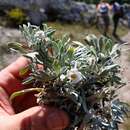en
names in breadcrumbs


Achillea ageratifolia, the Balkan yarrow or Greek yarrow, is a species of flowering plant in the daisy family Asteraceae, native to Greece and Bulgaria. Growing to 20 cm (7.9 in) tall and broad, it is a compact herbaceous perennial. It is a highly variable species, with three recognized subspecies. They have erect, simple, somewhat woody based stems.[4] The narrow grey-green foliage resembles that of a related genus Ageratum, hence the Latin specific epithet ageratifolia.[5] The solitary, daisy-like composite flower heads are white with yellow centres and about 2–3 cm across.[6] They appear May–July in the northern hemisphere.[7]
In cultivation in the UK, this plant has received the Royal Horticultural Society’s Award of Garden Merit.[8] An adaptable plant, it prefers a sunny, open position. It is hardy down to -10 to -15 degrees C.[7] It is also drought tolerant and grows well in USDA hardiness zones 3–8.[9] Common problems include aphids and downy mildew.[10]
It was first described in 1813 as Anthemis ageratifolia by James Edward Smith in Florae Graecae,[1][11] but was transferred to the genus Achillea by George Bentham & Joseph Hooker in 1873.[1][2] The genus name refers to the Greek hero Achilles, who is said to have used yarrow leaves to stop his soldiers' wounds from bleeding.[9]
Achillea ageratifolia, the Balkan yarrow or Greek yarrow, is a species of flowering plant in the daisy family Asteraceae, native to Greece and Bulgaria. Growing to 20 cm (7.9 in) tall and broad, it is a compact herbaceous perennial. It is a highly variable species, with three recognized subspecies. They have erect, simple, somewhat woody based stems. The narrow grey-green foliage resembles that of a related genus Ageratum, hence the Latin specific epithet ageratifolia. The solitary, daisy-like composite flower heads are white with yellow centres and about 2–3 cm across. They appear May–July in the northern hemisphere.